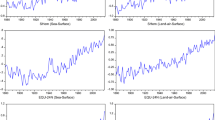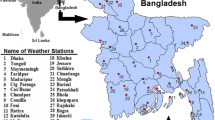Abstract
The annual temperatures recorded for the last two centuries in fifteen european stations around the Alps are analyzed. They show a global warming whose growth rate is not however constant in time. An analysis based on linear Arima models does not provide accurate results. Thus, we propose threshold nonlinear nonstationary models based on several regimes both in time and in levels. Such models fit all series satisfactorily, allow a closer description of the temperature changes evolution, and help to discover the essential differences in the behavior of the different stations.
Similar content being viewed by others
References
Auer I, Böhm R, Jurkovic A, Lipa W, Orlik A, Potzmann R, Schöner W, Ungersböck M, Matulla C, Briffa K, Jones PD, Efthymiadis D, Brunetti M, Nanni T, Maugeri M, Mercalli L, Mestre O, Moisselin J-M, Begert M, Müller-Westermeier G, Kveton V, Bochnicek O, Stastny P, Lapin M, Szalai S, Szentimrey T, Cegnar T, Dolinar M, Gajic-Capka M, Zaninovic K, Majstorovic Z, Nieplova E (2007) HISTALP— historical instrumental climatological surface time series of the Greater Alpine Region. Int J Climatol 27: 17–46
Bai J, Perron P (1998) Estimating and testing linear models with multiple structural changes. Econometrica 66: 47–78
Baragona R, Battaglia F, Cucina D (2004) Fitting piecewise linear threshold autoregressive models by means of genetic algorithms. Comput Stat Data Anal 47: 277–295
Baragona R, Battaglia F, Poli I (2011) Evolutionary statistical procedures. Springer, Berlin
Battaglia F, Protopapas MK (2011) Time-varying multi-regime models fitting by genetic algorithms. J Time Ser Anal 32: 237–252
Battaglia F, Protopapas MK (2012) Multi-regime models for nonlinear nonstationary time series. Comput Stat 27: 319–341
Bhansali RJ, Downham DY (1977) Some properties of the order of an autoregressive model selected by a generalization of Akaike’s EPF criterion. Biometrika 64: 547–551
Böhm R, Auer I, Brunetti M, Maugeri M, Nanni T, Schöner W (2001) Regional temperature variability in the European Alps: 1760–1998 from homogenized instrumental time series. Int J Climatol 21: 1779–1801
Böhm R, Jones PD, Hiebl J, Frank D, Brunetti M, Maugeri M (2010) The early instrumental warm-bias: a solution for long central European temperature series 1760–2007. Clim Change 101: 41–67
Cai Z, Fan J, Yao Q (2000) Functional coefficient regression models for nonlinear time series. J Am Stat Assoc 95: 941–955
Chan KS, Tong H (1986) On estimating thresholds in autoregressive models. J Time Ser Anal 7: 179–190
Chan KS, Tong H (1990) On the likelihood ratio tests for threshold autoregression. J R Stat Soc B 52: 469–476
Chatterjee S, Laudato M, Lynch LA (1996) Genetic algorithms and their statistical applications an introduction. Comput Stat Data Anal 22: 633–651
Chen C, Liu LM (1993) Joint estimation of model parameters and outlier effects in time series. J Am Stat Assoc 88: 284–297
Chen R, Tsay R (1993) Functional coefficient autoregressive models. J Am Stat Assoc 88: 298–308
Crawford KD, Wainwright RL (1995) Applying genetic algorithms to outlier detection. In: Eshelman LJ (ed) Proceedings of the sixth international conference on genetic algorithms. Morgan Kaufmann, San Mateo, CA, pp 546-550
Davis R, Lee T, Rodriguez-Yam G (2006) Structural break estimation for nonstationary time series models. J Am Stat Assoc 101: 223–239
Dueker MJ, Sola M, Spagnolo F (2007) Contemporaneous threshold autoregressive models: estimation, testing and forecasting. J Econom 141: 517–547
European Environment Agency (2008) Impacts of Europe’s changing climate—2008 indicator-based assessment. EEA report no. 4/2008. http://www.eea.europa.eu. ISBN 978-92-9167-372-8
Gaetan C (2000) Subset ARMA model identification using genetic algorithms. J Time Ser Anal 21: 559–570
Hamilton J (1989) A new approach to the economic analysis of nonstationary time series and the business cycle. Econometrica 57: 357–384
Holland JH (1975) Adaptation in natural and artificial systems. University of Michigan Press, Ann Arbor
IPCC Core Writing Team, Pachauri RK, Reisinger A (eds) (2007) Climate change 2007: synthesis report. Contribution of working groups I, II and III to the fourth assessment report of the intergovernmental panel on climate change. IPCC, Geneva. ISBN 92-9169-122-4
Kamgaing JT, Ombao H, Davis RA (2009) Autoregressive processes with data-driven regime switching. J Time Ser Anal 30: 505–533
Kennedy J, Eberhart R (2001) Swarm intelligence. Morgan Kaufman, San Mateo
Lin C, Teräsvirta T (1994) Testing the constancy of regression parameters against continuous structural change. J Econom 62: 211–228
Lundbergh S, Teräsvirta T, van Dijk D (2003) Time-varying smooth transition autoregressive models. J Bus Econ Stat 21:104–121
Marcellino M, Rossi B (2008) Model selection for nested and overlapping nonlinear, dynamic and possibly mis-specified models. Oxford Bull Econ Stat 70(Suppl): 867–893
Price KV, Storn R, Lampinen J (2005) Differential evolution, a practical approach to global optimization. Springer, Berlin
Priestley MB (1988) Non-linear and non-stationary time series analysis. Academic Press, London
Reeves CR, Rowe JE (2003) Genetic algorithms—principles and perspective a guide to GA theory. Kluwer, London
Rissanen J (2007) Information and complexity in statistical models. Springer, Berlin
Rivers D, Vuong Q (2002) Model selection tests for nonlinear dynamic models. Econom J 5: 1–39
Sin C-Y, White H (1996) Information criteria for selecting possibly misspecified parametric models. J Econom 71: 207–225
Teräsvirta T (1994) Specification estimation and evaluation of smooth transition autoregressive models. J Am Stat Assoc 89: 208–218
Teräsvirta T (1998) Modeling economic relationships with smooth transition regression. In: Ullah A, Giles DEA (eds) Handbook of applied economic statistics. Marcel Dekker, New York, pp 507–552
Tong H (1990) Non linear time series: a dynamical system approach. Oxford University Press, Oxford
Tong H, Lim K (1980) Threshold autoregression, limit cycles and ciclical data. J R Stat Soc Ser B 42: 245–292
Tsay RS (1988) Outliers, level shifts and variance changes. J Forecast 7: 1–20
Wu B, Chang CL (2002) Using genetic algorithms to parameters (d,r) estimation for threshold autoregressive models. Comput Stat Data Anal 38: 315–330
Wu S, Chen R (2007) Threshold variable determination and threshold variable driven switching autoregressive models. Stat Sin 17: 241–264
Zebisch M, Zimmermann P, Böhm R, Schöner W (2009) Climate change in the Alps. In: Regional climate change and adaptation—the Alps facing the challenge of changing water resources. European Environment Agency report no. 8/2009. http://www.eea.europa.eu. ISBN 978-92-9213-006-0
Author information
Authors and Affiliations
Corresponding author
Rights and permissions
About this article
Cite this article
Battaglia, F., Protopapas, M.K. An analysis of global warming in the Alpine region based on nonlinear nonstationary time series models. Stat Methods Appl 21, 315–334 (2012). https://doi.org/10.1007/s10260-012-0200-9
Accepted:
Published:
Issue Date:
DOI: https://doi.org/10.1007/s10260-012-0200-9




